Abstract
The article touches upon the issues of the approach to unproductive losses accounting on the basis of which the performance of a transport company is evaluated. The effectiveness of work is defined by the authors as the achievement of the interests of society in a favorable environment and the interests of an enterprise in the economic performance of its activities. In order to preserve the environment, it is necessary to ensure the interaction of the state and the enterprises of transport industry and solve the corresponding problems. Finding ways of efficient management and the best mechanisms for the allocation of scarce resources gives rise to the need for managing alternative costs or opportunity costs. The costs of missed opportunities as a part of every management decision are an indicator of lost profits. Lost profit arises during the choice of one of the alternative solutions. The benefit of the most valuable of rejected alternative solutions is the quantitative characteristic of lost profits. To meet the economic interests of the enterprise using the provisions of the theory of games, the authors developed a model for finding ways to effectively manage the enterprise in the system of environmental management. The model is based on the results of the analysis of the quality of environmental management decisions by assessing the retrospective dynamics of indicators such as current costs and investments in environmental protection and charges for permissible and excess emissions. The combination of these indicators makes it possible to take into account the multi-criteria and multi-aspect nature protection management decision-making process. The state strategy of environmental protection reflects the interests of society and sets the directions for improving the activities of corporations-users of natural resources.
Keywords: Efficiencycostsmanagementsolutionvaluationprofit
Introduction
The cost of production has always been a key factor affecting the profit of an enterprise. The issue is still relevant at the present time. An enterprise needs a choice of management strategy, which solves the problems of increasing the efficiency of enterprises based on the optimization of approaches to reduce costs.
The most important problem in this direction is the management of non-productive losses, which are caused by irrational environmental management and, accordingly, the increase in payments and penalties for excess emissions of pollutants into the atmosphere.
Problem Statement
The conditions of the systemic transformation of the Russian economy in the 1990s made it necessary to rethink almost all phenomena and processes.
The problem of production costs has always been of interest to economists, and the applied side of the issue becomes the most relevant in this period. Russian economists in their works tried to reflect the practical significance of the problem of production costs and their impact on the value of production costs. During this period, special attention begins to be paid to the applied aspects of the problem of production costs (Bubnova, Efimova, Sokolov, & Akopova, 2019). In addition, Russian researchers studied the issues of new approaches to the theoretical understanding of production costs. This aspect of the problems was revealed in the works with the help of theoretical analysis, both of the phenomenon itself and in the complex, and the assessment of the interconnection with other problems (Danubianu, 2017).
However, foreign economists also pay attention to the problem of production costs. The studies of foreign economists are more numerous. This is due to the experience of market development in Russia. In many respects, the studies of domestic and foreign economists intersect, since the studies of the former are based on the scientific potential of Western economic thought. In foreign literature, the problem of production costs is studied using economic and mathematical methods and is mostly has an applied nature (Sidawi 2014).
The costs of production are considered in the dialectical unity of the objective and subjective components. The objective side expresses economic relations regarding the implementation of various combinations of resources expended. The subjective aspects of production costs are realized in the method of the organization of economic activity and in the forms of economic thinking and behavior. (Tagiltseva, Kuzina, Drozdov, & Vasilenko, 2018).
On the other hand, the global problem of preserving the environment arises and attracts the attention of society. The desire of the company to impose liability and damage on enterprises-users of natural resources leads to an increase in environmental charges and fines, and as a result of unproductive losses. Such way of managing which would allow solving questions of efficiency of production and economic activity of the enterprise and environmental protection is necessary.
Research Questions
A new approach to the management of production costs is based on the influence of first, external factors, second, internal ones. The essence of the approach is that it is external factors that have a key effect on production costs. At the same time, a consistent assessment of external and then internal factors allows using the previous approach. The modern cost management strategy of the transport company allows evaluating the impact of unproductive losses, analyzing the development trends of the company while reducing unproductive losses and justifying the ways to increase the profitability and the prospects of the transport company management strategy (Tereshina & Sorokina, 2014).
There are several approaches to the concept of “unproductive losses”. One of them is the broad understanding that unproductive losses are the costs associated with the deficiencies in production and business activities. In other words, it is a quantitative characteristic of the assessment of the appearance of deficiencies in organizational and managerial activities.
Another approach reveals unproductive losses in a narrower sense and defines them as the cost of unproductive use of any resources, including time.
The fact that all unproductive losses are taken into account in the cost of production combines both approaches and the reduction of this cost item will ensure the reduction and decrease in the total price of the goods (Marchetti & Wanke, 2019).
Many economists highlight the subjective side of unproductive losses. These include incompetence and low qualification of managers of a transport company, lack of high-quality safe management decisions (Deljavan & Sadeghi, 2012). As a result, the imbalance appears in the socio-economic sphere in the solution of key problems, and the quality of management in transport companies decreases.
Transport corporations, aimed at the development of corporate social responsibility, are developing in a balanced and cost-effective manner. The strategy of such a company allows becoming attractive for socio-economic investments and influencing the solution of socio-economic problems at the regional level; The corporate sector, being a major participant in economic relations, sets the vector for the development of society in the territory of its presence and in the country as a whole, and solves its social problems (Savevska, 2014).
The system of corporate social responsibility of transport enterprises represents 3 development vectors: economic, environmental and social, shown in Figure
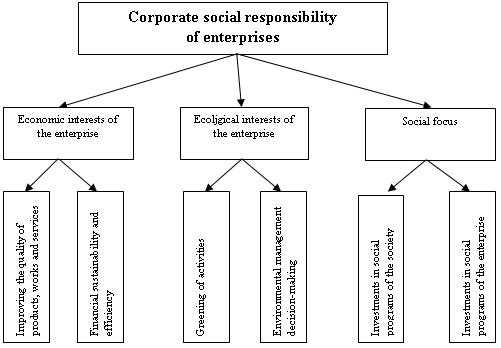
If we consider the results from the reduction of unproductive losses at a transport company in the conjunction with the corporate social responsibility system, we get a system for the management of the structure of unproductive costs in the interests of an enterprise and society, which is presented in Figure
(Tagiltseva, Kuzina, Drozdov, & Vasilenko, 2018).
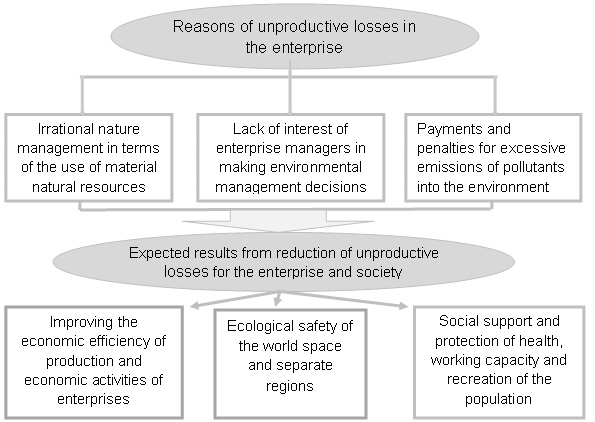
The desire of a person to meet their needs under the conditions of limited available resources, poses the main problem of the economy to solve. If a transport corporation uses measures of the reduction of unproductive losses in its management strategy, then the possibility of the solution of the main problem of the economy increases. The model of P. Samuelson (as cited by Tagiltseva et al., 2018) of the production curve is indicative in this situation. It allows graphical representing (Fig. 3) of environmental management decisions as a choice of alternatives, and evaluating the interdependence between them.
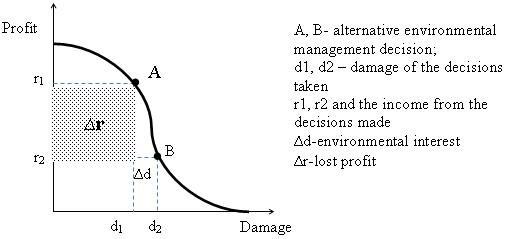
It can be concluded that the choice of an alternative to an effective managerial decision forms interdependence between the lost profit of a transport company and the environmental interest of the state or society.
Purpose of the Study
The purpose of the research is to develop an algorithm for assessing the economic efficiency of production and economic activity by reducing unproductive losses by the example of the transport industry of the country. To achieve this goal, it is expected to solve a number of scientific problems:
to determine the structure of non-productive losses and its relationship with the corporate social responsibility of the transport enterprise;
to analyze the dynamics of current costs and investments of transport industry enterprises in the environmental management system;
– to propose an algorithm for assessing the economic efficiency of production and economic activity of transport enterprises.
Research Methods
In Western countries, environmental payments are not widely used as a regulatory tool, as constant payments for emissions can contribute to environmental degradation. The study of the dynamics of the current costs and investments of the enterprise in the system of environmental management will assess the way of managing the enterprise of the transport industry and find the strategy of activity in which both tasks will be solved as much as possible: the profit of the enterprise and the environmental balance.
Game theory is used to justify the strategy. The power of game theory emphasizes strategic interaction between two or more players (Drozdov, Vasilenko, Kuzina, & Tagiltseva, 2018). Each player seeks to maximize their winnings provided that all other players also seek to maximize their respective payouts (Drozdov et al., 2018). Consequently, for n players, there are n maximum simultaneous challenges.
Findings
In order to perform the incentive function, the rates of environmental charges should exceed the costs of reducing emissions of pollutants. Otherwise, it is more profitable for the enterprise to make deductions than to reduce emissions (Dyczkowska, 2015). The search for ways to improve the management system required a retrospective analysis of the current costs of environmental protection of enterprises of the transport industry (Fig. 4) (Tagiltseva et al., 2018).
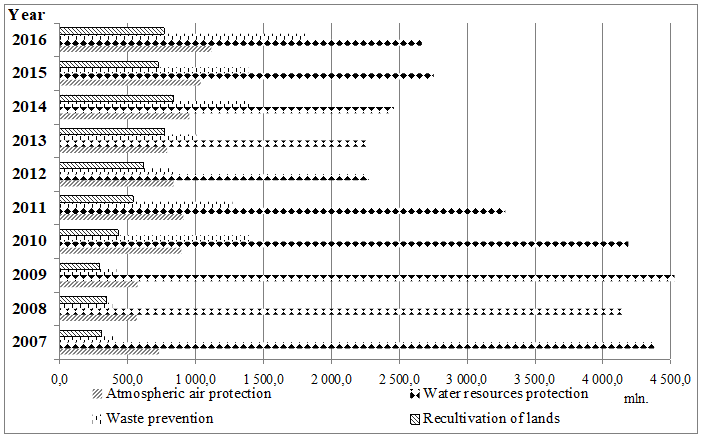
The current costs of environmental protection in connection with the formation of waste for the period from 2013-2016 have a positive trend and amount to more than 5 billion rubles, while the environmental payment is 2.3 billion rubles. It is obvious that this indicator can be taken into account as an indicator of improving the environmental and economic efficiency of the enterprise.
Let us consider the issues of investment in the system of environmental management of the transport complex of the country (Fig. 5).
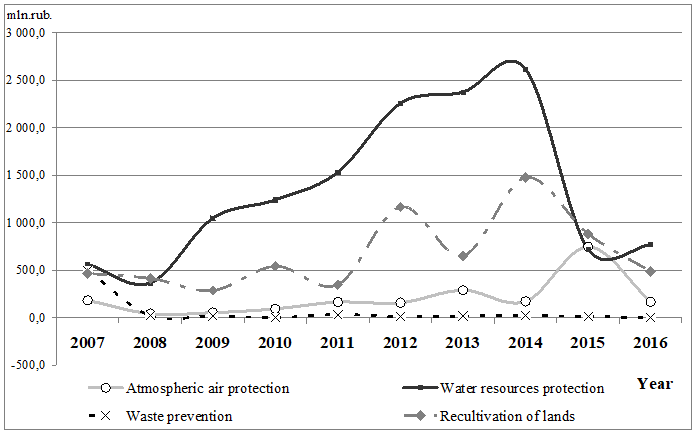
Long-term analysis of environmental investments in fixed assets shows that the investment directions of transport enterprises are ranked by the degree of decrease in invested funds as follows: (Rosolen & Ferranty, 2016):
Protection and rational use of water resources.
Recultivation of lands.
Atmospheric air protection.
Protection of the environment from the harmful effects of waste production and consumption.
The data presented in figures
Now let us talk in more detail about the players' winning and the method of its determination. Mathematically, the winning of the transport company has the formula:
Utran = (1 – C) + m, (1)
where С – payback ratio of the current costs of the transport enterprise for environmental protection measures;
m – coefficient of economy of the transport enterprise in payments for environmental management.
The payback ratio (C) characterizes the amount of costs incurred by the enterprise to obtain one ruble of income from environmental decision-making, which is determined by the formula:
С = ССcur / NP, (2)
where ССcur is the current costs of the transport company for environmental protection measures in million rubles. / year;
NP – net profit specified in form 2, in million rubles / year.
The coefficient of economy of the transport enterprise in payments for nature management m consists of the opposite indicator of the sum of expenses of the firm for payments for nature management, i.e.:
, (3)
where Psvn – payback ratio of payments for excess emissions in the net profit of the enterprise;
Pdv – payback ratio of payments for allowable emissions in the net profit of the enterprise.
Since the quantitative increase of these indicators (- m and C) means the deterioration of the financial position of the enterprise, when they are entered into the matrix table, the value of the player's win rate is deducted from the unit.
The scale of measurement of the coefficient m depends on what policy the state chooses, that is, this coefficient will decrease in the crisis scenario for the state and increase in the innovative scenario. Therefore:
in a crisis scenario: C → min, m → min;
in conservative scenario: C = Const, m → min;
innovative scenarios: C → max, m → max.
The payment matrix is built, taking as a utility the effectiveness of financial and economic environmental activities of the transport enterprise. Therefore, it can be argued that:
Strans = (CONS, INN, CRS);
Sgov = (CONS, INN, CRS);
Utrans = {-∞;1}.
When using the data of the constructed payment matrix, an algorithm for assessing the economic efficiency of production and economic activity of the transport enterprise is obtained (Fig. 6).
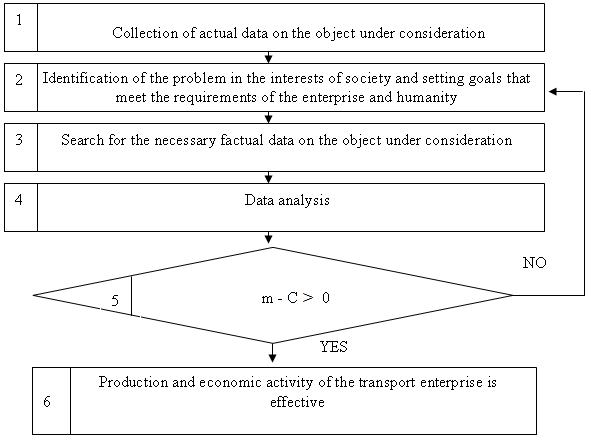
Analyzing these indicators, it is concluded that Utrans = m – C; that is, the utility deviates in a positive direction when the amount of saved payment for environmental management exceeds the financial costs for the modernization of enterprises, and in a negative – in the opposite situation.
Conclusion
Thus, the achievement of the key objective of the enterprise, which is to maximize profits, can not be realized without an assessment of non-productive costs and reflects the relationship and interdependence of environmental costs and investments in the system of environmental management in transport enterprises. The strategy of environmental activities should be aimed at obtaining an ecological and economic effect from reducing environmental damage and increasing the economic efficiency of production and economic activity of the transport enterprise. The definition of the latter is proposed to be carried out by correlating the current environmental costs and saving the transport company on payments for excess emissions in the process of environmental management.
References
- Bubnova, G. V., Efimova, O. V., Sokolov, Y. I., & Akopova, E. S. (2019). Management of risks and economic processes in Russian railways OJSC in digital economy. In Perspectives on the Use of New Information and Communication Technology (ICT) in the Modern Economy (pp. 320–325).
- Danubianu, M. (2017). Impact of corporate social responsibility on sustainable enterprise development. Present Environment and Sustainable Development, 11(1), 129–139.
- Deljavan, H. C., & Sadeghi, F. (2012). Introducing a model for competitiveness of suppliers in supply chain through game theory approach. Decision Science Letters, 1(2), 69–86.
- Drozdov, N. A., Vasilenko, M. A., Kuzina, E. L., & Tagiltseva, Y. A. (2018). Modeling of efficiency assessment for enterprises economic activity in environmental system. In 2018 IEEE International Conference "Quality Management, Transport and Information Security, Information Technologies" (IT&QM&IS), vol. 1 (pp. 98–102).
- Dyczkowska, J. (2015) CSR in TSL companies. Transport Problems, 10(1), 97–104.
- Marchetti, D., & Wanke, P. F. (2019). Efficiency in rail transport: Evaluation of the main drivers through meta-analysis with resampling. Transportation Research Part A: Policy and Practice, 120, 83–100.
- Nicoleta, S. (2013). The theory of the firm and the evolutionary games. Annals of the University of Oradea: Economic Science, 22(1), 533–542.
- Rosolen, T., & Ferranty, M. M. (2016). Strategic human resource management and corporate social responsibility: Evidence from Emerging Markets. Internext: Revista Eletrônica de Negócios Internacionais, 11(2), 66–80.
- Savevska, M. (2014). Corporate Social Responsibility: A Promising Social Innovation or a Neoliberal Strategy in Disguise? Romanian Journal of European Affairs, 14(2), 63–80.
- Sidawi, B. (2014). Traffic Safety: National Partnership and Corporate Social Responsibility. International Journal of Transportation Science and Technology, 3(1), 39–42.
- Tagiltseva, J. A., Kuzina, E. L., Drozdov, N. A., & Vasilenko, M. A. (2018). The Main Directions of Developing Organizational Measures at the Railway Enterprises in the Corporate Social Responsibility Aspect. In 2018 IEEE International Conference "Quality Management, Transport and Information Security, Information Technologies" (IT&QM&IS), vol. 1 (pp. 163–168).
- Tereshina, N. P., & Sorokina, A. V., (2014). Cost management of the transport company on the basis of process-oriented approach. Transport business of Russia, 1, 55–58.
Copyright information

This work is licensed under a Creative Commons Attribution-NonCommercial-NoDerivatives 4.0 International License.
About this article
Publication Date
28 December 2019
Article Doi
eBook ISBN
978-1-80296-075-4
Publisher
Future Academy
Volume
76
Print ISBN (optional)
-
Edition Number
1st Edition
Pages
1-3763
Subjects
Sociolinguistics, linguistics, semantics, discourse analysis, science, technology, society
Cite this article as:
Kuzina*, E., Barashyan, V., Tagiltseva, Y., Vasilenko, M., Drozdov, N., & Laponogova, A. (2019). Economic Efficiency Assessment Of Non-Productive Costs Management At The Enterprise. In D. Karim-Sultanovich Bataev, S. Aidievich Gapurov, A. Dogievich Osmaev, V. Khumaidovich Akaev, L. Musaevna Idigova, M. Rukmanovich Ovhadov, A. Ruslanovich Salgiriev, & M. Muslamovna Betilmerzaeva (Eds.), Social and Cultural Transformations in the Context of Modern Globalism, vol 76. European Proceedings of Social and Behavioural Sciences (pp. 1897-1906). Future Academy. https://doi.org/10.15405/epsbs.2019.12.04.254
